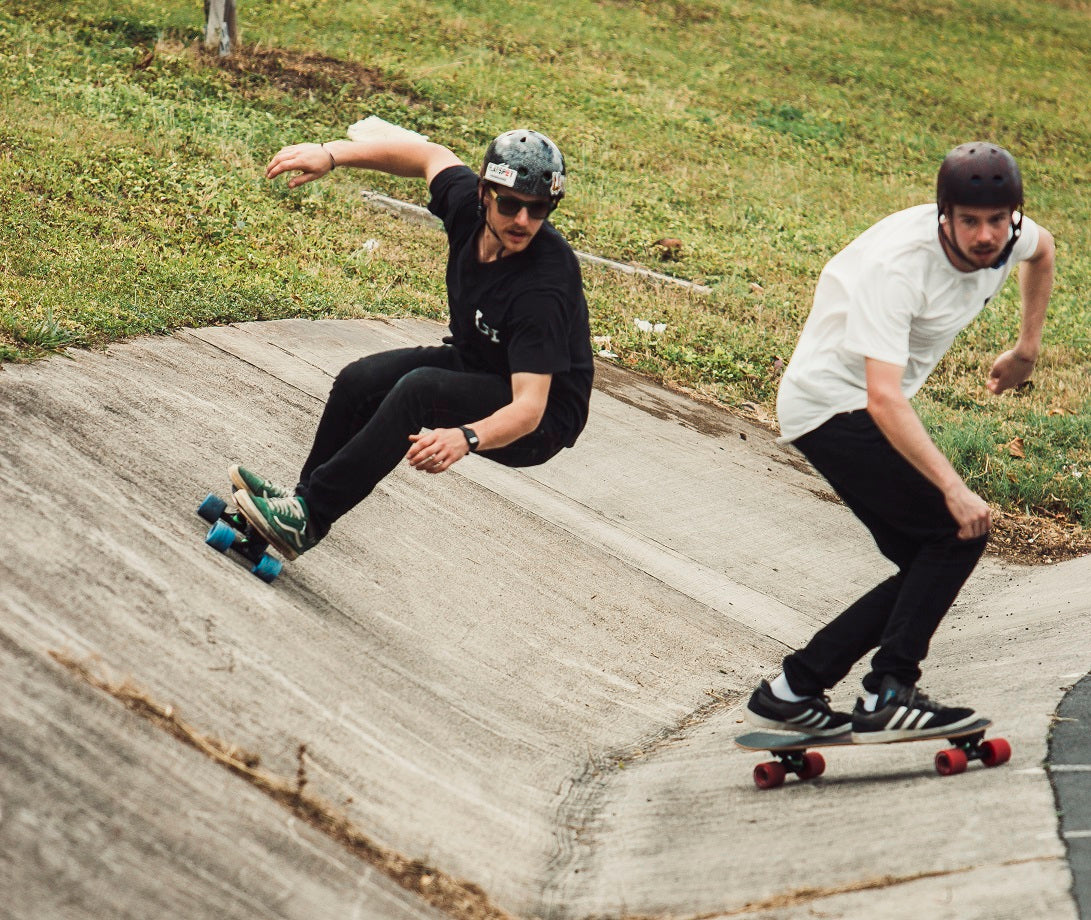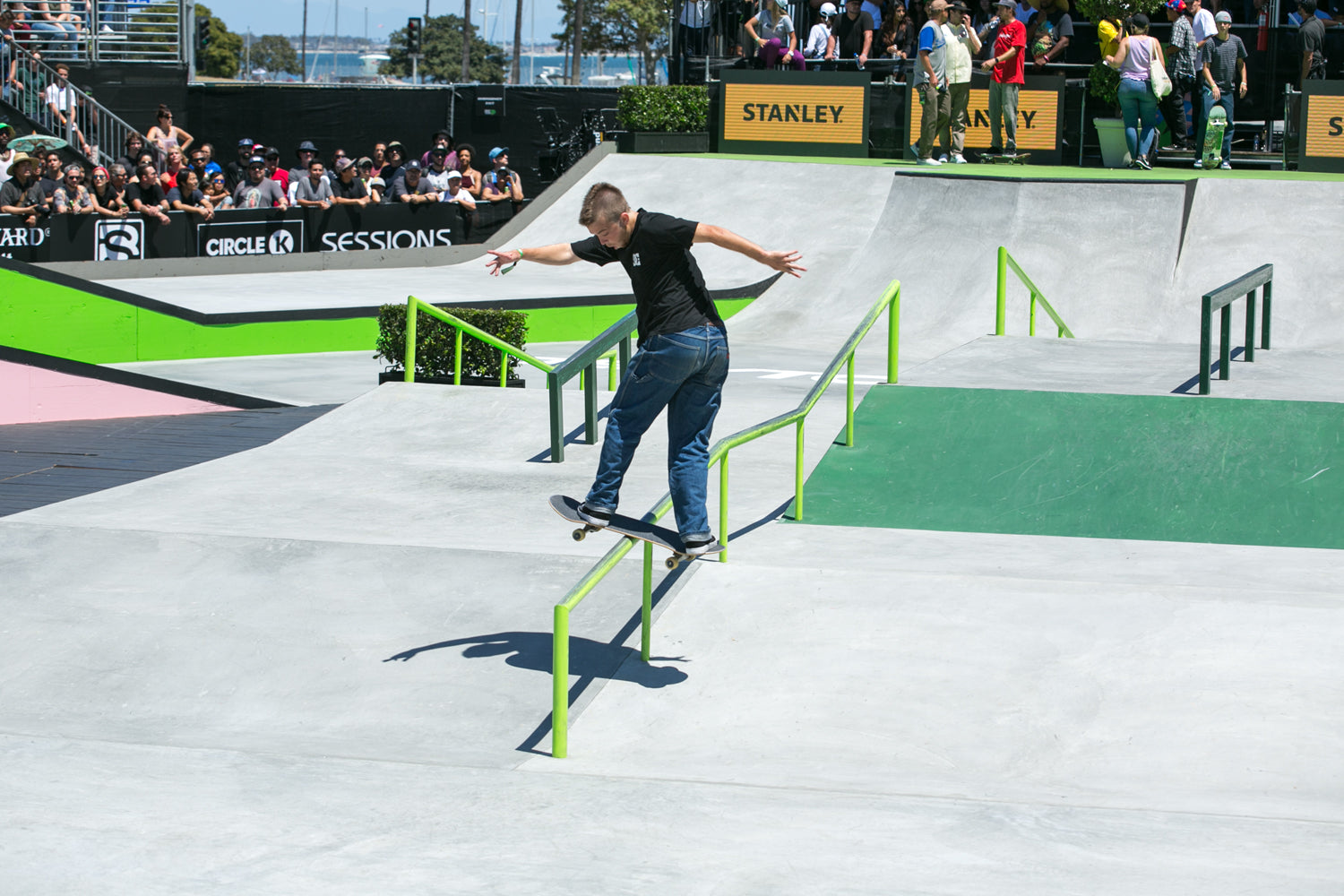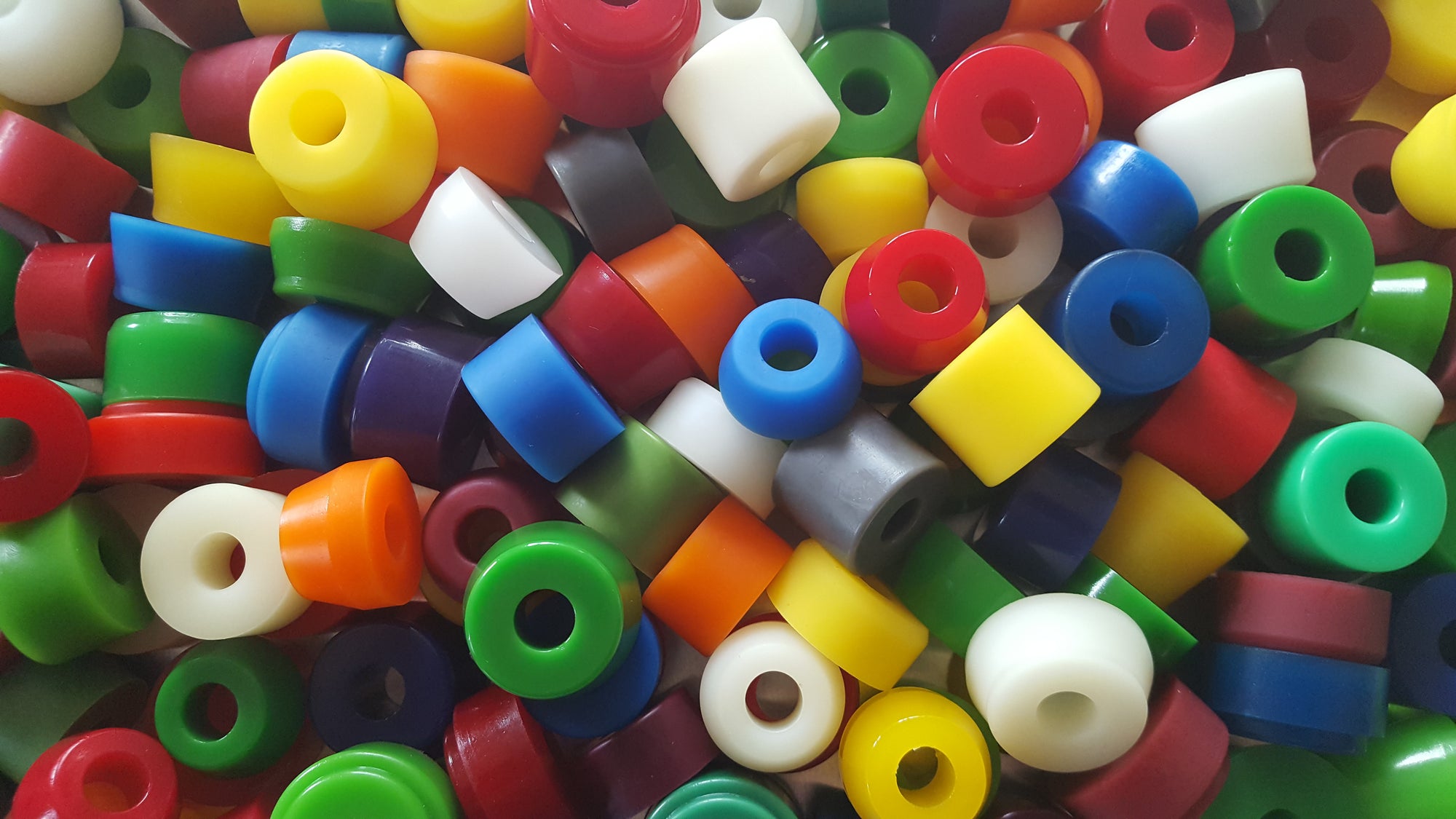If there’s something you should never skip looking over and spending good money on, it’s safety gear. The longboard community heavily encourages the use of helmets, gloves and other safety gear as needed. You won’t be uncool for wearing a helmet, in fact the likely thing to happen is that other riders will look down on you if you refuse to use safety gear.
Overview
Is longboarding dangerous?
Yes, it can be. Each discipline will have its own risk level, dangers, and common injuries.

If you’re into dancing, injuries from landing tricks incorrectly will be as common as street skating, but having a 42” board attack your shins will cause a bit more damage than a popsicle deck. One thing most people can agree on is that downhill skating is not as safe as cruising around campus; even then, by taking the necessary precautions it can be easier to avoid injury.
 |
 |
 |
 |
 |
 |
 |
 |
|
|
Park
|
Street
|
Vert
|
Slalom
|
LDP
|
Cruising/
Freestyle
|
Dancing
|
Downhill/
Freeride
|
|
|
Helmet
|
■
|
■
|
■
|
■
|
■
|
■
|
■
|
■
|
|
Gloves
|
|
|
|
|
|
|
|
■
|
|
Elbow pads
|
■ | ■ | ||||||
|
Knee pads
|
■ | ■ | ■ | ■ | ■ |
Key:
■ Must wear
■ Highly recommended
■ Advisable
Skateboarding injuries
Though there are not many recent studies on longboard specific injuries and accidents there is data on general skateboarding accident up to 2019 available in U.S. National Safety Council. Comparing skateboarding to baseball (there’s roughly the same amount of people that skate and play baseball in the US) we can see the numbers are pretty close. It is noteworthy to point out that most skaters are under 18.

Total injuries reported in 2019 per sport (Injury Facts)
According to the study “Boarding Injuries: The long and short of it” (it’s from 2014) data points towards longboard incidents overtaking regular skateboard injuries. This study however points at 91% of longboard injuries coming from Utah County. Inconclusive? Perhaps, also very dated, but one thing is for sure: longboard injuries, especially downhill related ones, can be way more serious. Beginners going downhill without helmet account for a significant chunk of it.
Safety gear
Helmets
The first obvious choice in safety gear are helmets. Do not even think about going fast without one and even for other “less dangerous” disciplines, it is not a bad idea to use one. Before buying one, make sure to check its certifications.
What the deal with certifications? It sounds complicated
It’s not. Certifications assure you your helmet won’t fail you when you need it the most; there’s no way to know when you will fall and hit your head hard. If it hasn’t happened to you, you probably haven’t been skating long enough. Apart from their odd number and letter names, certifications are fairly easy to understand.
The most common certifications used in skate and longboard helmets are CE, ASTM and CPSC. It’s just three, you have no excuse to not know them.

The bare minimum is to at least be certified. The weakest certification a helmet should have is ATSM F1492 for skateboard helmets. It can have others, it may not have an ATSM certification at all, but that is the least it should have.
The hard black foam inside a helmet is called expanded polystyrene or EPS. EPS absorbs the majority of impact force should a fall happen, so it’s important to know that it will hold up and it’s not just some cheap copy. Also keep in mind that helmets are meant to be single use, meaning that one direct hit to the head should be enough to get a new one. Even if the fall doesn’t seem bad the EPS could have been damaged. Indirect hits will cause abrasion damage to the shell, this is not necessarily a deal breaker. If the EPS is exposed throw it out, otherwise you will have to make the call. Being conservative with this is not a bad thing.
Buy helmets from known brands, trying to cheap out on helmets is a terrible mistake. Unlike other parts of your body, you only have one head – and the rest of your body can’t function without it. Do what you must to protect it.
Most skate helmets are certified for skateboarding; seems logical but, for some disciplines, falls can be quite more unforgiving and more safety is welcomed. While a helmet certification for skateboards for dancing, LDP or most other disciplines is enough, for faster riding it’s better to look at bicycle certifications since they’re held to a higher standard.
For example: an F1952 certification for downhill mountain bike helmets is held to a higher standard than F1447 for skateboard helmets. If you plan on going faster, an F1952 certification assure a lot more safety.
CPSC only cover bicycle certifications. A dual certified helmet with CPSC is bound to withstand whatever you throw at it.

Writer’s note: my own half shell is CE and CPSC certified. Notice the "EN-1078" underneath the CE marking.
Types of helmetsThere are 4 types of helmets you can use for skating: half-shells, full-cuts, full-face and aerolids.

The most common type of skateboard helmet. It will be good for every discipline. Compared to bicycle helmets, they are not as well vented and somewhat heavier; bicycle helmets do not cut it for skating as they are designed to take direct hits at certain angles – they do not protect the side of the head very well for example – helmets designed for skating will protect you just fine from most angles.
Full-cut helmets
Full-cut helmets are reminiscent of baseball helmets, but again, stick to things designed for skating. Half-shells do not protect the side of the face and jaw well enough, full-cuts make up for this by covering the ears and the back of the jaw. They are (in the writer’s humble opinion) just as comfy as half-shells and offer increased protection.
Full-face helmets
Full face helmets are a good option for advanced riders since they offer full protection to the face, sides of the head and chin. Full face helmets are not cheap but it is a necessary piece of equipment for any serious downhill and freeride rider. Always make sure to buy full faces from known and trusted longboard brands; snowboard, dirt bike or motorcycle helmets are not designed for skating – the lower visibility and the high weight can be a hazard.
Aerolids
If you’ve been skating for a while you might have heard of, or even seen, aerolids. Aerolids are full face helmets with fairings for greater aerodynamics.
[IMAGE]
Most of the time, aerolids lack chin protection which makes them not as safe as other full face helmets. Aerolids are only for professionals; they’re not meant to take abuse and are completely out of price range for most intermediate riders, not that it’d even make sense for them to get one. They’re not rare to see at more known downhill events and professional races.
Slide gloves
There is nothing specifically special about slide gloves, it just a glove with a velcroed puck. We will talk about each separately. You can make them at home if you don’t feel like buying them or you have some gloves you’d like to transform into slide gloves.
For folk just getting into the sport: wrist guards are not substitutes for slide gloves!
Gloves
All you need to know about gloves is that they should fit properly; never loosely. As for materials, leather will always last longest. Suede and denim are also used, these are good materials. Then you’ll also see synthetics and canvas, these do not last long but breathe better. There are also some gloves that come with knuckle protection, these are not as important as usually the only damage slide gloves take are to the finger tips – just have some duct tape handy to wrap ‘em up.
Pucks
Often overlooked, most folk will go for cheapest, prettiest, with good rep or the “one with the sparks”. For beginners will usually go for what’s most readily available – if you’re reading this, just buy Ojoom.
Most slide puck companies out there are small time operations run by skaters. Some don’t even have official website and will take requests through social media or email. Don’t be sketched out by this – as all small companies run by skaters, they really care about their customers.
There are three main characteristics to look at in gloves: material, shape and cool factor.
Material
Three materials are commonly used for pucks: delrin, uhmw and acrylic - though acrylic is the rarest of the three.

Shape
Pucks come in different shapes, ranging from circles to squares to octagons to ducks (yes, ducks). Generally, the point of slide puck being symmetrical is so that it can be flipped so they wear evenly. Rotating your pucks is necessary every few sessions, the edge closer to your wrist will tend to wear down faster.

Duck pucks were very unique and cool-looking. Check them out here
Cool factor and some recommendations
Remember, the coolest thing you can do is support your local brands. Other than that here are some pretty puck brands:
Holesum pucks – they smell!
CREMA FIRE pucks – they make sparks!
Ojoom – they are just cool
Shoes and socks
A lot of people seem to forget the importance of proper footwear.
For any longboard discipline it’s highly recommended to wear high socks, they will spare your shins some damage plus they look cool.
For downhill and freeriding, high top shoes could save your ankles from serious injury. Also keep in mind that high tops restrict movement so this really depends on the rider, some will prefer not to sacrifice movement even a little bit – or they just don’t like the looks of high tops. It’s been said before – the big evil capitalists at nike have been obsessed with making good shoes for a good time, and turns out they are pretty good. Nike dunks are a solid choice.
Also keep in mind that your soles will become one of your brakes, they will wear down fast. To prevent this, you can get yourself some brake soles: buy them or cut them from an old car tire.
Pads
Pads are a solid choice if you’re just starting out, have some trouble in any joint or you’re just not a fan of bleeding. Keep in mind that pads will considerably restrict your movement and sometimes it is safer to not have that restriction.
When you fall, you should always try to land on your gloves and the tip of your shoes. I would say pads are not as important as wearing long sleeves and denim pants or something more resistant – even that gets skipped on by a lot of more experienced riders.
Almost all pads are made out of delrin; they wear down faster than pucks but will help more to slow you down, though still you will be more prone to sliding right out of the road. There are also soft foam pads, these are great for wearing under some layer of clothing for absorbing impact; they will get destroyed by abrasion pretty fast if exposed. For both kinds, it is safer to use the ones that you wear “as a sock” instead of ones with Velcro straps, as they can come undone during a fall.
G-form shock absorbent pads: elbows and knees
Leathers
Lastly, leathers. This is just a quick note also, as there’s no need to use leathers. Yes, the leather will protect you from abrasion and if you combine it with a spine protector you will walk away from most falls unscathed, but the main purpose of leathers is being aerodynamic. They also look very cool.
Safe practices
Now you’ve got your skate gear and you’re ready to skate! But before you do so, there are some more things to check. When driving, having your seatbelt on doesn’t necessarily mean nothing will happen, you still must be mindful.
Keep your gear well maintained!
Is any of your bearings seized? Are your bushings in good shape? Are they overtightened or too loose? Are your trucks too tight? Bent? Are your wheels chunking? Are your nuts tight? Is your griptape in good shape? These are the kinds of questions you want to be asking yourself before skating. Is you’re cruising around campus and a nut comes lose you might fall and scratch yourself a bit, if you’re going down a hill it can cause serious injury.
Using the wrong gear can be quite a hazard for downhill skateboarding. Make sure you are using a board designed for the purpose. Your griptape must be in tiptop shape and be able to hold your feet during turns and slides. Your wheels should not be too hard, or you will slide out in every turn (check out our guide on wheels here). Your trucks should be meant for faster riding (we have a detailed guide here) and your bushings should be appropriate for your weight at the speeds you plan on going.
Obviously this doesn’t apply to experience riders, maybe you’ve seen videos of some going down hills in small cruisers or boards meant for dancing – they know what they are doing, or so we hope; don’t try it if you’re starting out.
Know the spot
The next question you should ask yourself is: is the spot ok to skate? Walk around and get a feel for it. This will be much faster for disciplines that are not freeride and downhill, for those two you will have to take a nice stroll (or car ride) to check it out. Look out for sand, rubble, potholes, cracks in the road, possible sources of traffic or pedestrians and oil. Motor oil on the road is not something pleasant to find unknowingly.
Spotters
Lastly, you should ask: is there anyone I could hit or could hit me? Running over a pedestrian is not the best, getting run over by a car is something you want to avoid at all cost.
WARNING: Not for the faint of heart
Having a spotter for your street skate sesh is fine, they can call out cars or pedestrians and typically you won’t need more than one. It is slightly more difficult if you are planning to skate down a hill with turns which my hinder your visibility. The best idea is to use walkie-talkies and have a buddy ride down the hill before you, calling out anything that might be dangerous. You could also have spotters at places where traffic flows merges into the road, in case the car misses a car or bike or something that might put the riders in danger.
If you’re not skating your usual spots, consult with the local skaters. They will know best.
Even more
Learn even more about skate safety at skateboardsafety.org. They have excellent information on everything safety related.
Always remember to buckle your helmet and be safe out there, skating is a lot more fun when you don’t hurt yourself too often.








